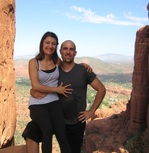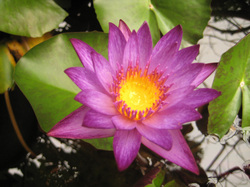
"Toward the end of his life, the Buddha took his disciples to a quiet pond for instruction. As they had done so many times before, the Buddha’s followers sat in a small circle around him, and waited for the teaching.
But this time the Buddha had no words. He reached into the muck and pulled up a lotus flower. And he held it silently before them, its roots dripping mud and water.
The disciples were greatly confused. Buddha quietly displayed the lotus to each of them. In turn, the disciples did their best to expound upon the meaning of the flower: what it symbolized, and how it fit into the body of Buddha’s teaching.
When at last the Buddha came to his follower Mahakasyapa, the disciple suddenly understood. He smiled and began to laugh. Buddha handed the lotus to Mahakasyapa and began to speak.
“I have experienced the true Dharma eye, the marvelous mind of Nirvana, the true form of the formless, the subtle Dharma Gate that does not rest on words or letters but is a special transmission outside of the scriptures. This I entrust to Mahākāśyapa.” (
www.katinkahesselink.net)
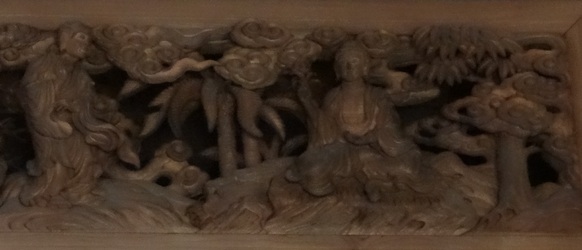
The story of the flower sermon, Buddha's transmission of the truth beyond words and letters, above the main altar of the Butsuden in Eiheiji monastery
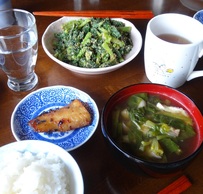
Miso soup was waiting for us!
From Tokyo, Neda & I were excited to head up to the mountains of the Nagano prefecture, in the small town of Shiojiri, to visit
our friends from Bodhgaya, India who had invited us to their hometown. When Rika first heard we actually were going to visit her up in the mountains, she was surprised and ecstatic. After all, she had invited other “gaijin” (foreigners) on her travels, but none had actually come to visit. She wrote excitedly, “Miso soup will be waiting for you!” and we knew that we were in for a warm welcome and looked forward to seeing Japanese culture from a more intimate perspective.
The first place we stopped was at Kouryu-ji Temple, the home of Toha-Osho and his family. Toha was one of two Zen Priests we met at Nippon-ji and he had taken care of us while we were in India. While we caught up over tea, we told Toha we would try to visit Eiheiji Temple after our visit with them, but only for the day because it seemed impossible to arrange for a longer visit when we called with Rika from India because we didn’t speak Japanese. It is a training monastery and they can only handle English speakers on specific dates when they have prepared for it. Eiheiji is an important place of pilgrimage for Neda and me because it is the home monastery of the Soto Zen Sect, which we practiced at the Austin Zen Center. We also talked to him about recommendations on where to buy some calligraphy, which we wanted as a souvenir from Japan. He told us, “Calligraphy very expensive to buy. I will make some for you.”
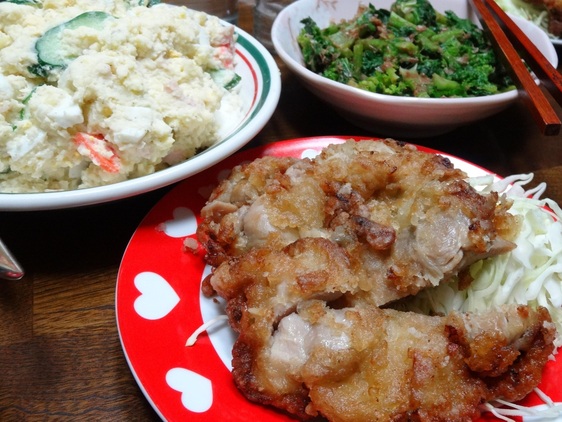
Delicious Sanzoku-Yaki, (山賊焼き) (deep fried teriyaki chicken thigh) with homemade greens
It was this kind of utter generosity that made us feel like we were at a home far away from home. Arriving at Rika’s house her mother had brought us some of the local specialty, Sanzoku-Yaki, (山賊焼き) (deep fried teriyaki chicken thigh) and prepared fresh miso soup and greens. We waited until the evening for our friend Riko (also from Bodhgaya in India), who came up to join us from Chiba, near Tokyo.
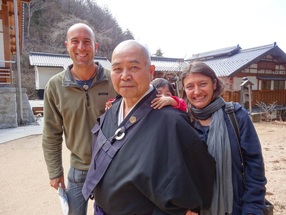
Rev. Ogasawara and his granddaughter
Then it was off to a busy day as we headed to Kotaku-ji Temple to visit with Rev. Ogasawara (the senior priest from Bodhgaya, who had led the sesshin there). We enjoyed tea with him and discussed Zen before
everyone got to try their hand ringing the temple bell! Then we headed off to Matsumoto Castle, which features the oldest five-tiered keep in all of Japan. The sun gleamed off of the “black crow”, named after the dark hues of the stained wood of the castle. Hitoshi-san (Rika’s Dad) told us about an interesting feature of the castle, which is that it actually has 6 floors (instead of the 5 you see from the outside), one of which is a hidden floor where gunpowder and other valuables were stored.
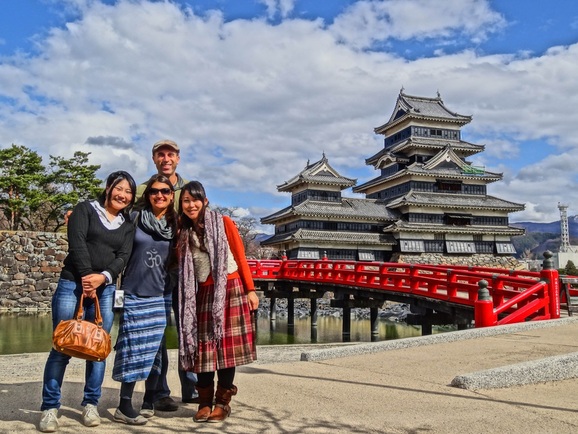
From left, Rika, Neda, Jeff & Riko enjoying a day at Matsumoto Castle
On our return back to Shiojiri, we visited Toha-osho’s temple again, where he told us that he had spoken to the folks at Eiheji and they did have a foreign group visiting on April 1st and we could join them, if Toha-osho came along. So he told us he would drive us out to the temple (5 hours!), stay with us overnight and then head back. Sugoi! (Amazing in Japanese). Rika agreed to join us and we had our road trip/pilgrimage set!
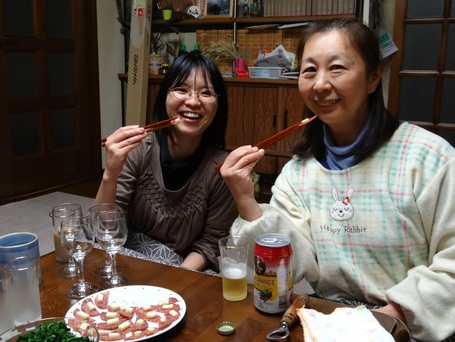
Chizuko-san and Humina-San try Bulgarian appetizers Japanese style (with chopsticks!)
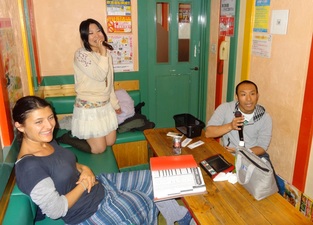
The next few days passed like a spring breeze as Rika’s brother Shu-san, sister-in-law Humi-san and little niece Yuki came to visit for the weekend. We had an amazing time as we cooked them a
Bulgarian meal (served Japanese style) and went out with Shu & Rika for
a night of fun Karaoke (which for those who might not know, originated in Japan). The next day was all preparation as the family readied the
“irori” for a grand feast that night. Their irori was built by Hitoshi-san and his father in a small separate house off the main house. It consists of tatami mats surrounding a special pit filled with sandy earth. Over the pit goes the grill, and when the fire is ready
all sorts of delicious meats and veggies are lovingly cooked. We sampled tender grilled scallops still in the shell and finished off with some butter, marinated beef, Japanese mushrooms, succulent chicken legs, shrimp, and
hand caught little sweet-fish that you eat whole. Toha-osho joined us for the gathering and on his way in, nonchalantly handed us some beautiful calligraphy he had made for us, despite being terribly busy with a funeral service over the past couple days. The night finished with the family sharing some special
Cherry-blossom infused sake with us to try – the delicate blooms still floating in the fragrant liquid.
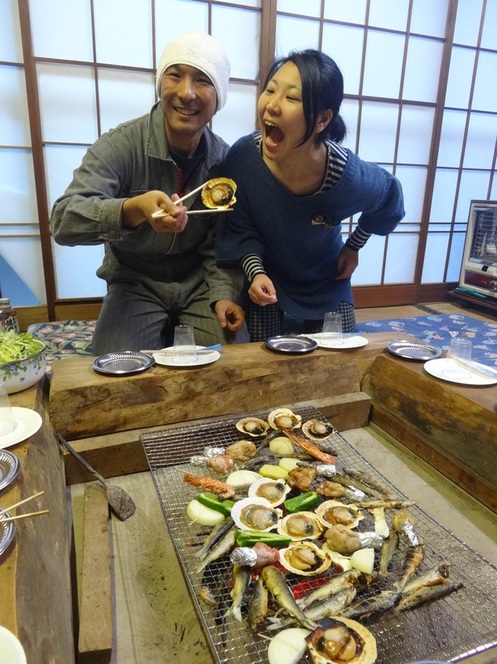
Rika enjoys a scallop from brother Shusuke-san during our irori feast!
On Sunday, our last day together with the whole family, we took
everyone out for Kaiten-zushi (sushi-train), which is adorable in Japan. Not only is there the normal sushi moving around the conveyor belts, but when you make custom orders it comes to you on a mini-bullet train (Nozomi Shinkansen) that stops at your table before zooming off to the next stop. Sugoi!
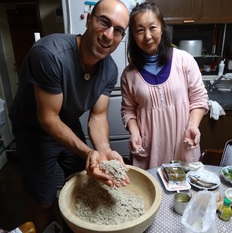
The evening was another highlight as Chizuko-san, Rika’s mother, took us into the kitchen and taught us how to make home-made soba noodles. We learned to serve them warm where they are dipped into a vegetable laden soup with a bamboo strainer. But the local specialty is to serve them cold on a bamboo basket (zaru-soba) where you eat the noodles by dipping them into a light soy broth and then quickly slurp them into your gullet! Hitoshi-san showed us how it was done brilliantly the first time, but I wanted to capture it on video. Sufficed to say, the 2nd attempt wasn’t as cleanly executed,
but it made for this hilarious video!
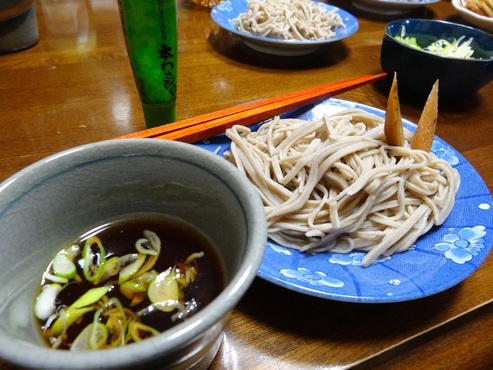
Our homemade zaru-soba! Note that the thicker noodles were the attempts by Neda & me!
You might be wondering by now why this post opened with the story of Mahakasyapa. In the story, Mahakasyapa is the only disciple to understand that connecting deeply to the reality of all things is not dependent on words, but comes only from direct experience. A corollary of this lesson could be that our connection as human beings is also not dependent upon words. There has been no time where we felt this more deeply than at Rika’s house, where other than Rika, no one else in the family spoke more than a few words of English! Here we were bonding with the family, cooking together,
playing with the little Yuki-monster and yet not actually communicating in words. We truly felt like a part of the family and yet we hadn’t actually ever “spoken” to anyone in the family besides Rika. The experience taught us the power of just being present together to bind and connect people in a fundamental way. We left the family laden with gifts of calligraphy and art that Chizuko-san and her teacher had made and with heavy hearts that the time had passed so quickly. Toha-Osho came for us at 5am to start the road trip to Eiheiji. Chizuko-san (by now called Mama-san) made some coffee and tea and she and Hitoshi-san (who we called Papa-san) saw us off as we left for the next adventure! To see all the
pics and videos of our time in Shiojiri and Matsumoto click here: 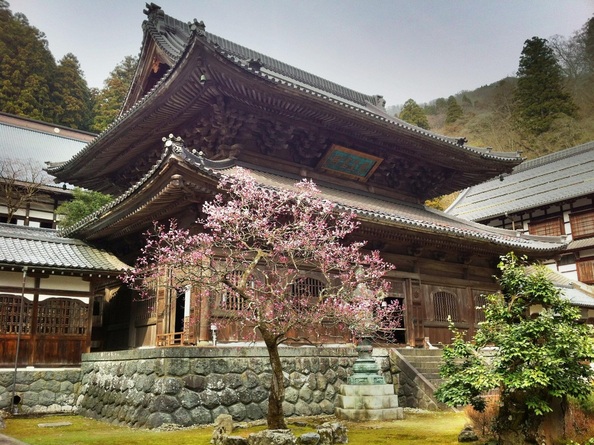
Butsuden at Eiheiji
Eiheiji is perhaps the most important place of pilgrimage for Soto Zen practitioners. It is here that founder Dogen established his training monastery in 1244 and where his first writing, the Fukanzazengi (Universally Recommended Instructions for Zazen) is stored. Today it is a full training monastery with over 200 monks in residence.
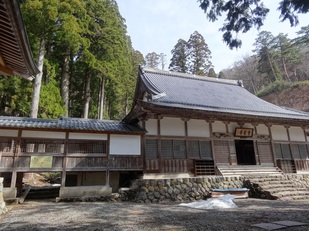
But we didn’t go straight to Eiheiji – instead Toha Osho took us on a historical tour of Zen Buddhism in the region, taking us first to the remote
Hokyo-ji Temple, which was founded by Dogen’s friend and student, Jackeun after Dogen’s death. It is unique because it is one of few Zen temples founded by a foreigner and was founded after a schism at Eheiji over leadership caused Jackeun to leave. Jackeun’s students would continue to lead Eiheiji until 1468 when the lineage of Keizan (who founded Soji-ji temple) assumed leadership.
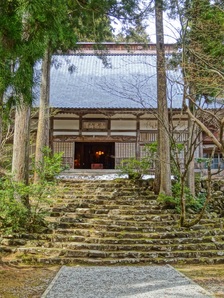
Next we visited Kippo-ji, a temple where Dogen lived over a cold winter in 1243, writing many parts of the Shobogenzo during that time. It is important in Zen practice because it was during this time that
Dogen started to elevate monastic practice over lay practice. It is thought this may have been because the winter had caused the monks’ morale to be very low and that Dogen was attempting to inspire them while Eiheiji was being built. Interesting how even great Zen Masters have to make compromises to keep popular support, huh? One of the most memorable parts of the visit to the monastery was a flat rock in the back of the grounds were it is said that Dogen meditated.
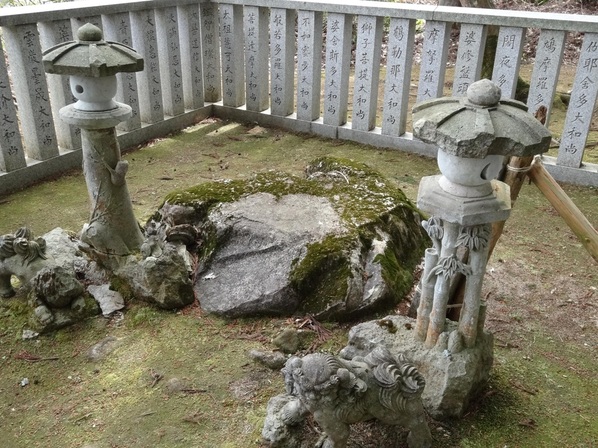
Dogen's meditation rock at Kippo-ji. The writing on the pillars behind lists the lineage of teachers reaching from Buddha to Dogen
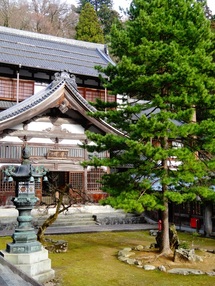
Finally, we made it to Eiheiji, a temple completed only 10 years before Dogen’s death. It was his realization of a dream to have an ideal training monastery nestled in the mountains and rivers of nature. Rev. Kuroyanagi, head of international students, had come from his home temple in Nagano to lead a group of Karate practitioners on a tour of the temple and to receive and introduction to zazen. We knew the zazen part, but we still appreciated seeing the
Joyoden (founders hall), where Dogen’s remains are interred and to practice the morning service in the Hatto (Dharma Hall). It was quite an experience to walk down the isle to offer incense while surrounded by the reverberating chants of 200 Zen monks. They even offered my name during the chants for well-being (my name had been on the register of guests). While doing all of this, Toha-Osho cheerfully tagged along and pointed out tiny aspects we might have missed (he practiced at Eiheiji when he was younger). We felt such tremendous gratitude to this man who had sacrificed his time just to show a couple of foreigners around this special temple!
One further note on Eiheiji – it was the first time we had seen a Japanese Soto Zen monastery functioning fully with monks and it made us truly appreciate the training we had received at the
Austin Zen Center under our teacher Seirin Barbara Kohn. We understood all the forms they were using at the temple and in many ways it felt a bit like home. Barbara did a great job of creating a little microcosm of a Zen monastery right there in the heart of Austin! Strangely, American Zen Centers now seem to retain the forms and practices of Eiheiji and Soto Zen to much greater extent that temples in Japan, which have largely become places for ceremonial practices rather than zazen and zen training.
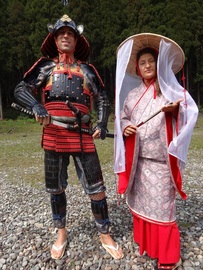
When the morning came (bright and early at 3:30am!) and zazen, services, and breakfast were over, we left Eiheiji and thought we would head to the station to say our goodbyes. But Toha-Osho had one more surprise in store for us. As we all nodded off to sleep (we only slept 3 hours or so the previous night) he took us to the Ichijodani Asakura Clan ruins, where they have reconstructed the town built up around the
Asakura Family Mansion, which was burned down by Oda Nobunaga in 1568. There Toha-Osho and Rika cajoled us to don a samurai costume for Jeff and a kimono for Neda, making for some of the most hilarious pics on the trip so far!
See all the pics of our pilgrimage to Eiheiji here!
Our time with Toha-Osho, Rika, and her family, was inspiring beyond words. It showed us the power of love and generosity to shine through even when there is almost no connection through language. It was a metaphor for all of Zen practice for us – to find compassion and wisdom beyond words and letters and to thereby live more authentic lives. There is no greater gift. Domo arigato gozaimasshta!

















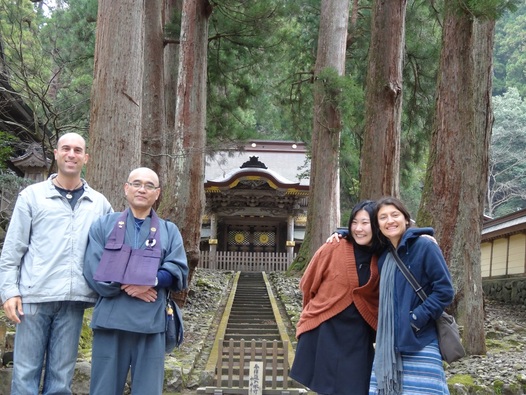
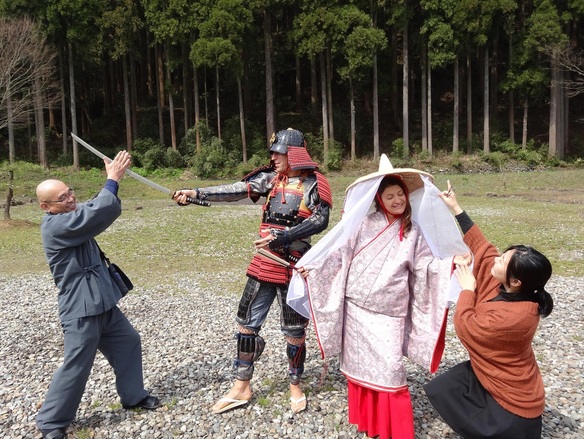
 RSS Feed
RSS Feed